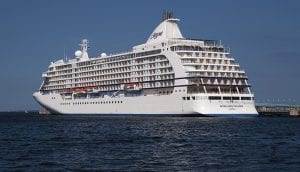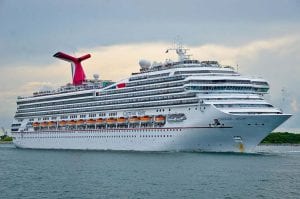As norovirus surges, Trump’s cutting of the CDC’s Vessel Sanitation Program will kill off the VSP’s major work of keeping American cruise ship passengers safe.

The EHSPD manages the Vessel Sanitation Program (VSP). That program conducts cruise ship health inspections. It also tracks and investigates outbreaks of gastrointestinal illnesses in cruise ships.
It would seem that the loss of the VSP program at this time is particularly troublesome.

It looks to be a serious blunder for the CDC to eliminate the Vessel Sanitation Program, particularly now, or even reduce it. The surge of norovirus outbreaks at sea mirrors outbreaks on land. Starting at the end of November 2024, according to CDC data, land-based outbreaks reported by U.S. state health departments surged. Comparing outbreaks from late November 2024 through February 2025 to the maximum number of weekly outbreaks from 2021 through 2023, there is an overall outbreak increase of 1.3 times those in past years. That’s 988 more outbreaks this year compared to the past. To give a little more perspective on the norovirus surge being experienced in 2025, the levels of norovirus reported in the U.S. are generally their highest since 2012.
Public health experts have revealed that a new strain of nororvirus is at the crux of the recent outbreak surge.

Carnival Valor Cruise Ship
Public health experts are saying that the steep curve of surging norovirus cases is due to a new strain of norovirus named GII.17[P17]. Since 2012, more than a decade ago, the dominant strain of norovirus in the U.S. and on cruise ships traveling in and out of the U.S. has been GII.4. Scientists tell us that now, only about seven percent of norovirus outbreaks have been linked to GII.4.
According to CaliciNet, the national norovirus outbreak surveillance network of public health laboratories in the U.S. that is coordinated by CDC, almost 70 percent of samples from norovirus patients in recent months tested as the new dominant norovirus strain, GII.17[P17].
Any significant reduction in the VSP will put American cruise ship passengers at serious risk.
With norovirus cases surging in the U.S. and aboard cruise ships with American passengers on board, a new strain of the virus is emerging as the dominant norovirus strain. It is the first major change in norovirus pathology in more than a decade. It should be obvious to anyone who cares about the well-being of American cruise ship passengers that the decision to eliminate the EHSPD, and, therefore, the Vessel Sanitation Program, is wholly unreasonable.
The Vessel Sanitation Program provides many more services than monitoring norovirus and other gastrointestinal disease outbreaks on cruise ships. It’s a cooperative program established 50 years ago, in 1975, under President Gerald R. Ford. The program works with the cruise industry to help them fulfill their responsibility to the cruising public through the development of “comprehensive, performance-based” health systems. Much of the cooperation from the cruise ship industry comes in the form of fees payable to the CDC to offset much of the cost of the VSP.
The VSP is more than tracking gastrointestinal viruses. It’s inspection, training, and education to prevent illness on cruise ships of all sizes.

In addition to the inspections, the VSP “conducts ongoing surveillance of gastrointestinal illness and coordinates/conducts outbreak investigations on vessels.” The VSP also provides food safety and environmental sanitation training for cruise line vessel, shore and management personnel. It consults with cruise lines reviewing plans for cruise ship renovations and new construction, even going to shipyards to review ongoing construction and fully inspecting vessels upon their initial call at a U.S. port. The VSP also works to educate the cruising public on what they can personally do to protect themselves from illness while cruising.
The VSP is our first line of defense against cruise ship health problems.
Some of the myriad of issues that the VSP handles include:
- Gastrointestinal illness surveillance
- Potable water issues
- Wastewater collection and disposal issues
- Swimming pool, whirlpool and hot-tub health issues
- Food safety including storage, preparation, cooking, serving, waste disposal
- Pest management
- Housekeeping issues including sanitation of cabins and public areas, linen, laundry, etc.
- Child activities health issues
- Medical systems sanitation issues
The VSP protects passengers on commercial cruise ships of all sizes, not just the larger cruise ships, and needs to do far more than merely inspect vessels for health compliance.
Cruise ships, small, medium, large and super-sized are like towns and small cities with regard to public health issues. Ensuring that the ships are well designed to handle health and sanitation issues and have well-trained personnel to carry out the necessary procedures is a huge job for the VSP in partnership with the cruise industry.
It takes a full staff of experts in the field with significant support staff considering the difficulties of running the VSP effectively with so many ships who call on the U.S. and many more being constructed and renovated across the globe that will call on U.S. ports once ready to sail.
The Administration now states that they haven’t shut down the VSP. Large ship inspections will continue, only a small part of what it does. It looks like the rest of their job has been stripped, endangering the cruising public.
Seeing in the news many reports about how the VSP was listed in a Department of Health and Human Services (HHS) document as being eliminated, the CDC responded saying, “This work has not stopped, as the VSP is primarily staffed by USPHS (U.S. Public Health Service) commissioned officers who were not subject to the reduction in force.”
In addition, another HHS spokesperson stated that 12 USPHS officers will remain with the VSP and will continue the work of inspecting large ships.
What about smaller ships? What about education and training? What about ship design review?
Twelve inspectors with massive cuts in support staff can’t possibly continue the twice annual inspections of all cruise ships calling on U.S. ports from foreign itineraries that carry 13 passengers or more and carry out the VSP’s duties with regard to gastrointestinal outbreaks, training, education and design review. This is particularly true due to the new dominant norovirus strain causing a tremendous surge in outbreaks and individual cases at sea.

If you’re interested at all in cruising, tell the Trump Administration to reinstate the VSP and all their support personnel and the others in the CDC who ensure that the VSP can do their job well.
I call on everyone interested in cruise travel to join me in calling on the Trump Administration to immediately and fully reinstate the VSP and bring back its full staff, including support personnel and the needed personnel to assist the VSP in the rest of the CDC and in particularly its EHSPD.
(Image: Regent Seven Seas Voyager at Tallin, Estonia. Copyright © 2018 NSL Photography. All Rights Reserved.)
READ ALSO:
Is my hotel room safe? Can I leave my valuables? Here’s how to find out.
Travelers United works with aviation industry on sustainable aviation fuel
After many years working in corporate America as a chemical engineer, executive and eventually CFO of a multinational manufacturer, Ned founded a tech consulting company and later restarted NSL Photography, his photography business. Before entering the corporate world, Ned worked as a Public Health Engineer for the Philadelphia Department of Public Health. As a well known corporate, travel and wildlife photographer, Ned travels the world writing about travel and photography, as well as running photography workshops, seminars and photowalks. Visit Ned’s Photography Blog and Galleries.



